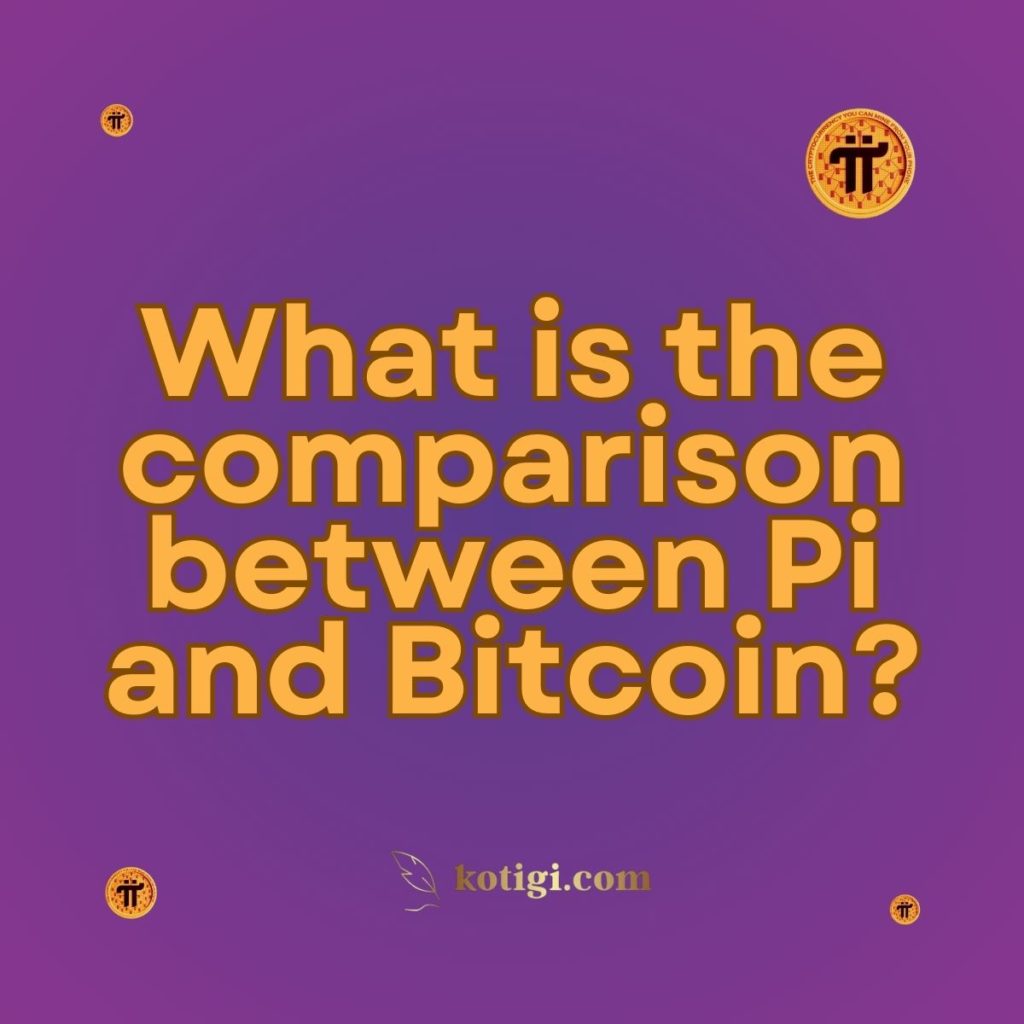
What is the comparison between Pi and Bitcoin?
Pi Network and Bitcoin represent two distinct approaches to cryptocurrency, each with unique features and use cases. While Bitcoin is a pioneering decentralized digital currency known for its store of value and speculative trading, Pi Network focuses on user accessibility, community engagement, and practical utility in everyday transactions. This article explores the key differences and similarities between Pi and Bitcoin, shedding light on their respective roles in the cryptocurrency landscape.
Introduction
Cryptocurrencies have revolutionized the financial landscape, introducing decentralized systems that empower individuals to engage in peer-to-peer transactions without intermediaries. Among the thousands of cryptocurrencies available today, Bitcoin stands out as the first and most recognized digital currency, often referred to as “digital gold.” On the other hand, Pi Network, a newer entrant, aims to create a user-friendly cryptocurrency accessible to everyone, enabling everyday transactions without the technical barriers often associated with traditional cryptocurrencies. This article compares Pi and Bitcoin across several dimensions, including technology, accessibility, use cases, community engagement, and future potential. By examining these aspects, we can gain a clearer understanding of how Pi Network positions itself in the cryptocurrency ecosystem and its potential impact on users and investors alike.
Comparison table Pi Network vs Bitcoin
Here’s a comparison table highlighting the key differences and similarities between Pi Network and Bitcoin:
| Feature | Pi Network | Bitcoin |
|---|---|---|
| Launch Year | 2019 | 2009 |
| Founder(s) | Nicolas Kokkalis, Chengdiao Fan, Vincent McPhillip | Satoshi Nakamoto |
| Consensus Mechanism | Stellar Consensus Protocol (SCP) | Proof of Work (PoW) |
| Mining Method | Mobile mining accessible to all users | Requires specialized hardware and significant energy consumption |
| Total Supply | Not capped; community-driven distribution | Capped at 21 million coins |
| Transaction Speed | Faster transaction speeds due to mobile-first design | 7 transactions per second (TPS) |
| Main Use Case | Peer-to-peer transactions, decentralized applications (dApps) | Store of value, investment asset, peer-to-peer transactions |
| Accessibility | Highly accessible via mobile app | Requires technical knowledge and hardware investment |
| Community Engagement | Strong focus on user participation and referrals | Community-driven but driven by speculation |
| Market Capitalization | Still developing; not yet established | Highest market capitalization among cryptocurrencies |
| Regulatory Status | Aims for compliance and transparency | Varies by jurisdiction; some regulations and scrutiny |
| Environmental Impact | Minimal impact due to low energy consumption | High due to energy-intensive mining process |
| Future Potential | Focused on creating practical utility and adoption | Established as a leading digital asset with institutional interest |
Technology and Architecture
The technological foundations of Pi Network and Bitcoin are among the most critical factors that differentiate the two cryptocurrencies. Their underlying protocols, consensus mechanisms, and scalability solutions have significant implications for their usability and performance.
Blockchain Technology
Bitcoin operates on a robust and established blockchain protocol, utilizing a decentralized ledger to secure transactions and prevent double-spending. It employs a proof-of-work (PoW) consensus mechanism, which requires miners to solve complex mathematical problems to validate transactions. This process is energy-intensive, leading to concerns about its environmental impact and scalability.
In contrast, Pi Network employs a unique consensus mechanism called the Stellar Consensus Protocol (SCP), which relies on a network of trusted nodes to validate transactions without the need for energy-intensive mining. This innovative approach allows Pi to be mined on mobile devices, making it more accessible to a broader audience.
Scalability Solutions
Bitcoin has faced significant scalability challenges, particularly during periods of high network congestion. The Bitcoin network can handle around 7 transactions per second (TPS), which can lead to delays and increased transaction fees during peak usage times. Solutions like the Lightning Network aim to address these issues by enabling faster and cheaper transactions, but widespread adoption remains a challenge.
Pi Network’s design allows it to handle a larger volume of transactions without the same level of congestion. Its mobile mining and user-friendly approach facilitate scalability, enabling users to participate in the network without extensive technical knowledge.
Security Features
Bitcoin’s security relies on its decentralized network of miners and the PoW mechanism, making it resistant to attacks. However, the network’s security can be compromised if a malicious entity gains control of more than 50% of the mining power, known as a 51% attack.
Pi Network, on the other hand, utilizes a security model based on trusted nodes and user participation. While this model reduces energy consumption, it raises questions about decentralization and security. The long-term implications of this approach will depend on how the network evolves and how trust is established among users.
Accessibility and Usability
The accessibility and usability of a cryptocurrency are vital factors that determine its adoption and user engagement. Pi Network and Bitcoin differ significantly in this regard, with implications for their respective user bases.
Mobile Mining
One of the standout features of Pi Network is its mobile mining capability. Users can mine Pi coins directly through a mobile app, which requires minimal resources and technical knowledge. This accessibility enables a broader demographic, including those new to cryptocurrency, to participate in the mining process and earn coins without significant financial investment.
In contrast, Bitcoin mining typically requires specialized hardware, significant energy consumption, and technical expertise. This barrier to entry limits participation to those who can afford the necessary equipment and resources, making it less accessible to the average person.
User Experience
Pi Network prioritizes user experience with a straightforward mobile interface, enabling users to engage easily with the network, mine coins, and connect with others. This emphasis on usability encourages more people to explore cryptocurrency and engage in the Pi ecosystem.
Bitcoin, while functional, can be more challenging for newcomers to navigate. Setting up wallets, understanding transaction fees, and managing private keys require a certain level of technical knowledge that may deter some potential users.
Community Engagement
Community engagement is essential for the growth and sustainability of any cryptocurrency. Pi Network fosters an active and engaged community by incentivizing user participation through rewards and referral programs. Users are encouraged to invite others, participate in discussions, and contribute to the development of the network, creating a sense of ownership and belonging.
Bitcoin also has a robust community of enthusiasts and advocates, but its growth has often been driven by speculative trading and investment rather than grassroots engagement. While Bitcoin’s community is dedicated, it lacks the same level of incentivization for user participation compared to Pi Network.
Use Cases and Applications
The practical applications of a cryptocurrency play a significant role in its adoption and utility. Both Pi and Bitcoin offer unique use cases that cater to different audiences and objectives.
Store of Value
Bitcoin is often referred to as “digital gold” due to its limited supply and deflationary nature. Many investors view it as a store of value, seeking to hedge against inflation and economic instability. This perception has contributed to Bitcoin’s status as a leading cryptocurrency, with institutional investors increasingly recognizing its potential.
In contrast, Pi Network aims to provide a currency for everyday transactions rather than serving primarily as a store of value. While Pi coins can potentially appreciate in value, the focus is on creating a medium of exchange that facilitates peer-to-peer transactions and supports the local economy.
E-Commerce Integration
Bitcoin has gained acceptance among numerous online retailers and merchants, allowing users to make purchases using their coins. This integration into the e-commerce space enhances Bitcoin’s utility, enabling users to leverage their holdings for real-world purchases.
Pi Network is still in the early stages of establishing partnerships and integrating with merchants. However, its potential for future e-commerce applications is promising, as Pi coins could be used for purchasing goods and services, particularly in a decentralized marketplace tailored to its user base.
Decentralized Applications (dApps)
Bitcoin’s primary function is as a currency, but it also supports various projects and initiatives within the broader blockchain ecosystem. While it is not as versatile as some other platforms, Bitcoin has paved the way for the development of decentralized applications and financial services.
Pi Network aims to create a thriving ecosystem of dApps that users can access with Pi coins. By prioritizing user engagement and practical applications, Pi has the potential to foster innovation and growth within its network, enhancing its overall utility.
Economic Models and Tokenomics
The economic models and tokenomics of a cryptocurrency significantly influence its value and user engagement. Both Pi and Bitcoin have unique approaches to token distribution, inflation rates, and overall supply.
Supply and Distribution
Bitcoin has a capped supply of 21 million coins, making it a deflationary asset. The process of Bitcoin halving, which occurs approximately every four years, reduces the rate at which new coins are created, reinforcing its scarcity and driving demand. This capped supply has contributed to Bitcoin’s perception as a store of value.
In contrast, Pi Network’s supply dynamics are different. The total supply of Pi coins is not predetermined, and the project emphasizes community-driven distribution. Users earn Pi coins through mining and engagement rather than purchasing them on exchanges, creating an inclusive ecosystem focused on accessibility.
Inflation and Deflation
Bitcoin’s deflationary nature is a key factor in its value proposition. As the supply decreases over time due to halving, the scarcity of Bitcoin can lead to price appreciation as demand increases. This deflationary model has attracted investors seeking long-term growth.
Pi Network’s inflation model is designed to incentivize user participation and community growth. While the lack of a capped supply may raise concerns about inflation, the emphasis on user engagement and real-world utility aims to balance this concern. The tokenomics of Pi are still evolving, and the long-term implications of its supply model will become clearer as the network matures.
Market Capitalization
Bitcoin currently holds a dominant position in the cryptocurrency market, with the highest market capitalization among all cryptocurrencies. This established status attracts institutional investment and enhances its credibility as a digital asset.
Pi Network is still in the early stages of market development, and its market capitalization remains to be established. The future of Pi’s market performance will depend on user engagement, partnerships, and the overall growth of its ecosystem.
Regulatory Considerations
As cryptocurrencies gain popularity, regulatory scrutiny has increased. Understanding the regulatory landscape is essential for both Pi and Bitcoin, as it affects their adoption and long-term viability.
Compliance and Regulations
Bitcoin has faced regulatory challenges in various jurisdictions, with governments grappling with how to classify and regulate cryptocurrencies. While some countries have embraced Bitcoin and other cryptocurrencies, others have imposed strict regulations or outright bans. Navigating this regulatory landscape is crucial for Bitcoin’s continued growth and acceptance.
Pi Network aims to operate within regulatory frameworks to foster compliance and build trust with users and authorities. By prioritizing transparency and engagement, Pi seeks to establish itself as a legitimate player in the cryptocurrency market.
User Safety
Regulatory considerations also impact user safety and protection. Bitcoin’s decentralized nature can make it challenging for users to seek recourse in cases of fraud or loss. In contrast, Pi Network’s emphasis on community engagement may enhance user safety by fostering a supportive environment where users can share experiences and knowledge.
Future Implications
The evolving regulatory landscape will significantly impact both Pi and Bitcoin. As governments establish clearer frameworks for cryptocurrencies, projects that prioritize compliance and transparency are likely to succeed. The adaptability of both networks in navigating these challenges will play a critical role in their long-term viability.
Conclusion
The comparison between Pi Network and Bitcoin reveals two distinct approaches to cryptocurrency, each with its strengths and challenges. Bitcoin, as the pioneering digital currency, boasts a robust and secure ecosystem, recognized as a store of value and investment asset. However, its accessibility and usability limitations can deter potential users.
On the other hand, Pi Network aims to democratize cryptocurrency by offering a mobile-first approach, making mining accessible to anyone with a smartphone. Its community-driven model and focus on practical utility position it as a potential player in the digital economy, but its long-term success will depend on user engagement, market adoption, and the evolution of its tokenomics.
As the cryptocurrency landscape continues to evolve, understanding the differences and similarities between Pi and Bitcoin is essential for users and investors alike. Both cryptocurrencies have the potential to contribute to the ongoing transformation of the financial system, but they represent different paths toward achieving their goals.
Key Takeaways
- Bitcoin is the first cryptocurrency, known for its security and store of value, while Pi Network focuses on accessibility and community engagement.
- The technological differences between Bitcoin’s proof-of-work mechanism and Pi Network’s consensus model highlight their unique approaches to scalability and usability.
- Bitcoin serves primarily as a store of value, while Pi Network aims to facilitate everyday transactions and support a diverse ecosystem of applications.
- Understanding the tokenomics and market dynamics of both cryptocurrencies is essential for navigating their potential investment opportunities.
- Regulatory considerations play a critical role in the future viability of both Pi and Bitcoin, shaping their adoption and user engagement.





